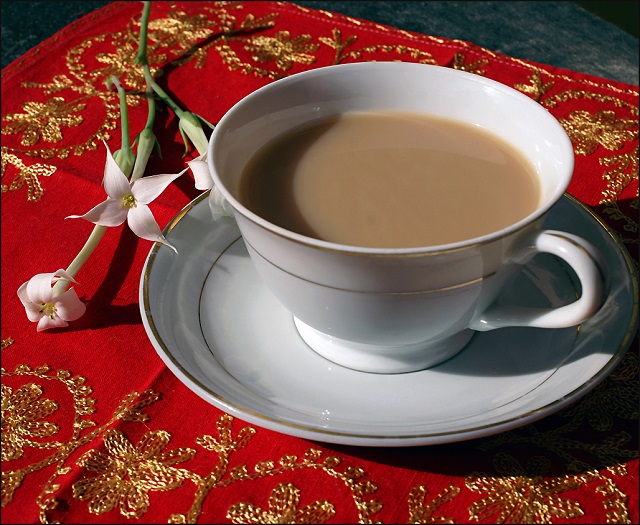India is well-known for its Masala chai.
In Hindi, “Masala” is a spice blend, and “chai” is tea leaves. It is known that tea leaves came to India from China as a result of the Silk Road trade. Orange Pekoe, which is a classic black loose-leaf tea, is the perfect tea leaf to make chai.
Many teashops, known as chai wallah, open at 4:00 a.m. and begin the process of preparing chai. They cook this concoction for hours, and the resulting chai is quite strong. The chai is highly caffeinated like espresso. Also known as “cutting,” chai is served as a small shot.
Masala chai is the morning wake-up call in every household in almost all parts of India, except the South. Growing up, whoever woke up first in the house had the duty of boiling the raw milk that was delivered by the milkman in the wee hours of the morning and preparing chai for everyone. Since I am an early bird, I did this for several years. I fondly remember conversations I had with my dad during those early hours in the morning, as he was a morning person as well.
In a small pot, the water is boiled along with green cardamom pods and fresh ginger root that is roughly chopped. The most important step in the chai-making process is boiling the ginger root. The root is cooked in water because this helps break down the acidity from the ginger that can sometimes curdle the milk. Tea leaves are then added to the boiling water. After cooking the tea leaves for a couple of minutes, hot milk is added, along with sugar, and the chai is cooked a little longer.
Cooking it further allows the tea to get stronger, which makes for a great chai. The art of a great chai is to cook it for some time after milk has been added—this is distinct from English Tea, in which milk is added to black tea in a cup.
A chai latte, often found at coffee shops, has almost nothing to do with the original Indian chai. It is a variation and is a lot creamier and sweeter, hence adding a lot more calories.
A small portion of chai, usually four to five ounces, is served in a chai glass—or a cup with saucer—and is enjoyed by all. Sometimes, instead of adding cardamom and ginger, a spice blend (masala) is added to flavor tea; this blend contains black pepper, ground ginger, ground cardamom, ground cloves, and some other spices—hence the name, Masala chai.
In addition to Masala chai, herbal teas made from various herbs and roots are also consumed during winter season, but these herbal teas do not contain any tea leaves, milk, or sugar.
~
Masala Chai Recipe.
Serves: 2
Ingredients:
1 cup water
2 green cardamom pods, muddled
1 inch fresh ginger root, roughly chopped
2 teaspoons Orange Pekoe tea leaves (black loose tea)
1 cup of hot whole milk
2 teaspoons sugar
~
Instructions:
In a two-quart saucepan over medium heat, boil water. Add cardamom and ginger.
Once the water with the cardamom and ginger comes to a boil, add tea leaves and boil for one minute.
Add milk and sugar, then allow the chai to cook for about three minutes. Reduce heat to low, as the milk may boil over.
Strain using a tea strainer and serve.
Note: If you are using a spice blend (see below), use one teaspoon for the recipe above.
~
Spice Blend for Masala Chai.
Serves: 24 (So you can save some for next time!)
Ingredients:
2 Tablespoons cloves
2 Tablespoons green cardamom pods
1 teaspoon black peppercorn
1/2 cinnamon stick, broken into two pieces
2 Tablespoons ground ginger
1 teaspoon ground nutmeg
~
Instructions:
In a coffee or a spice grinder, add all the ingredients and blitz until ground.
Store in an air-tight container. This spice blend should last for two years. It is even better to store the spice blend in a freezer, so that it retains its freshness even longer.
Enjoy!
~
Relephant:
Indian Comfort Foods for Winter. {Recipes}
~
Author: Rupen Rao
Image: Flickr/Ute
Editor: Yoli Ramazzina
Copy editor: Travis May









Read 0 comments and reply